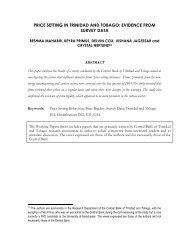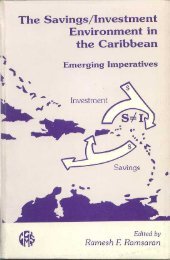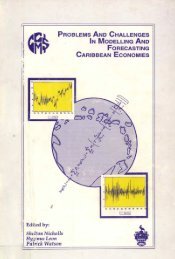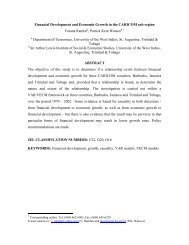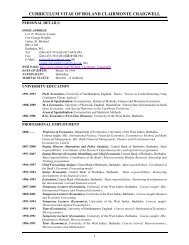Download
Download
Download
You also want an ePaper? Increase the reach of your titles
YUMPU automatically turns print PDFs into web optimized ePapers that Google loves.
72 / BUSINESS, FINANCE & ECONOMICS IN EMERGING ECONOMIES VOL. 2, NO. 1, 2007<br />
where ϖ = domestic ination and s is real depreciation.<br />
Based on the above expression, increases in the variance of<br />
ination for a given variance of real exchange rate depreciation are<br />
associated with increases in dollarization. Ize and Levy-Yeyati (1988)<br />
found evidence that the equilibrium portfolio largely approximates<br />
actual dollarization for a broad sample of countries. The model suggests<br />
that asymmetries between depositors’ and borrowers’ portfolios could<br />
generate deviations from this equilibrium.<br />
Recent studies have typically investigated the vulnerabilities<br />
associated with increased nancial dollarization. Levy-Yeyati (2004)<br />
augmented previous work by Ize and Honohan (2003) which found<br />
evidence that nancial dollarization increases solvency and liquidity<br />
risks in the banking sector. Domac and Bahmani-Oskooee (2002)<br />
summarized pertinent concerns in the literature related to the impact<br />
of dollarization on the implementation and effectiveness of monetary<br />
policy. They outlined that dollarization jeopardizes the effectiveness of<br />
the transmission mechanism by: (i) reducing the yield of the ination<br />
tax, resulting in higher and more volatile ination, for a given budget<br />
decit, (ii) reducing the monetary authorities’ control over domestic<br />
liquidity both by inducing shifts away from local money holdings and<br />
increasing the volatility of domestic money demand, (iii) affecting<br />
the choice of exchange rate regime and (iv) increasing the exposure<br />
of the banking system to additional risks on account of uncovered<br />
foreign liabilities, thus complicating the intermediation channel for<br />
effecting monetary policy.<br />
3.0 Factors inuencing the Development of Financial Dollarization<br />
in Jamaica<br />
Financial dollarization in the Jamaican economy was spawned by<br />
the economic liberalization process of the late 1980s and early 1990s. The<br />
liberalization process involved nancial system and foreign exchange<br />
market reforms, including the elimination of exchange controls, allowing<br />
residents to hold foreign currency. Since then, there has generally been<br />
a steady rise in dollarization in the Jamaican economy. During the



